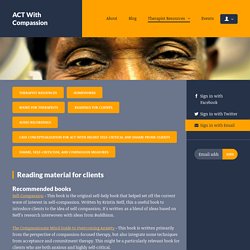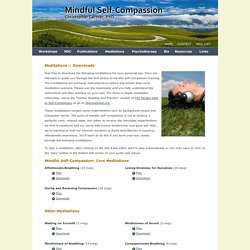

Relaxing Forest Waterfall Nature Sounds-Birds Singing-Natural Calming Sound of Water for Sleeping. Exercise 3: Exploring self-compassion through writing. Part One: Which imperfections make you feel inadequate?

Everybody has something about themselves that they don’t like; something that causes them to feel shame, to feel insecure, or not “good enough.” It is the human condition to be imperfect, and feelings of failure and inadequacy are part of the experience of living a human life. Try writing about an issue you have that tends to make you feel inadequate or bad about yourself (physical appearance, work or relationship issues…) What emotions come up for you when you think about this aspect of yourself? Try to just feel your emotions exactly as they are – no more, no less – and then write about them. Part Two: Write a letter to yourself from the perspective of an unconditionally loving imaginary friend Now think about an imaginary friend who is unconditionally loving, accepting, kind and compassionate.
Part Three: Feel the compassion as it soothes and comforts you After writing the letter, put it down for a little while. Readings for clients - ACT With Compassion. Recommended books Self-Compassion - This book is the original self-help book that helped set off the current wave of interest in self-compassion.

Written by Kristin Neff, this a useful book to introduce clients to the idea of self compassion. It's written as a blend of ideas based on Neff's research interwoven with ideas from Buddhism. The Compassionate Mind Guide to Overcoming Anxiety - This book is written primarily from the perspective of compassion-focused therapy, but also integrate some techniques from acceptance and commitment therapy. Guided Meditation with Sam Harris. Christopher Germer, PhD, author of The Mindful Path to Self-Compassion; clinical psychologist specializing in the application of Buddhist psychology and meditation to alleviate difficult emotions in psychotherapy and everyday life.
Feel free to download the following meditations for your personal use.

They are intended to guide you through the first phase of mindful self-compassion training. The meditations are primarily instructional in nature and briefer than most meditation sessions. Please use the downloads until you fully understand the instructions and then practice on your own. For more in-depth meditation instruction, check the "Further Reading and Practice" section of The Mindful Path to Self-Compassion or go to DharmaSeed.org.
These meditations contain some imperfections such as background noises and misspoken words. To play a meditation, after clicking on the link it will either start to play automatically or you may have to click on the "play" button in the bottom left corner of your audio web player. What Does Mindfulness Meditation Do to Your Brain? The views expressed are those of the author and are not necessarily those of Scientific American.

As you read this, wiggle your toes. Feel the way they push against your shoes, and the weight of your feet on the floor. Really think about what your feet feel like right now – their heaviness. If you’ve never heard of mindfulness meditation, congratulations, you’ve just done a few moments of it. More people than ever are doing some form of this stress-busting meditation, and researchers are discovering it has some quite extraordinary effects on the brains of those who do it regularly. Originally an ancient Buddhist meditation technique, in recent years mindfulness has evolved into a range of secular therapies and courses, most of them focused on being aware of the present moment and simply noticing feelings and thoughts as they come and go.
Credit: Sebastien Wiertz via Flickr The “functional connectivity” between these regions – i.e. how often they are activated together – also changes. Busy Life Meditation. Busy Life, No SelfBy Joseph Goldstein I was recently thinking about some close friends who are younger than I am, raising families, with busy lives in the world.

I could appreciate that it might be quite some time before they would be able to sit a long retreat, where it’s easier to access meditative depths. When we’re otherwise intensely engaged, this can be quite a challenge. So I started wondering if there was a way for people with busy lives to integrate some kind of meditation technique into their daily activities that would still touch the transformative power of the practice. The basic understanding of anatta, or ‘no-self’ – the absence of an inherently existing self – is one of the most difficult concepts to work with. So the question arose, how can we address this issue as lay people caught up in our day-to-day activities? Session 1: Who is Hearing? The other exercise for loosening identification with the body is carried out in motion.
Mindfulness Meditation: 8 Quick Exercises That Easily Fit into Your Day. You can fit these mindfulness exercises into your life while walking, brushing your teeth and just listening.

Although mindfulness meditation is all the rage nowadays, most people have little time for formal practice. That’s a pity since studies have found mindfulness meditation has many benefits, including reducing depression and pain, accelerating cognition, increasing creativity, debiasing the mind and much more. If you’re looking for a quick and easy way to add a little mindfulness meditation to your day without formal practice, then these mindfulness exercises are for you. They mindfulness exercises can mostly be slotted in while you go about your everyday business, without the need for a formal sit-down meditation session. 1.
If you do any period of undisturbed walking during the day — at least ten or fifteen minutes — then you can do a little walking mindfulness meditation. It’ll be easiest if done somewhere with fewer distractions, but try it anywhere and see what happens. 2. 3. 4.